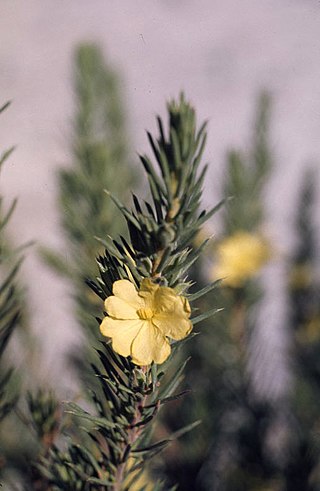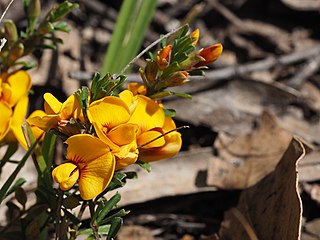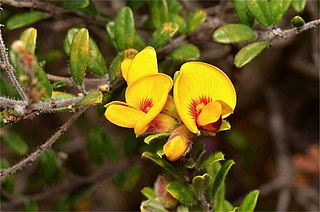
Eutaxia parvifolia is a species of flowering plant in the family Fabaceae and is endemic to southwestern Western Australia. It is a shrub with reddish brown stems, elliptic to egg-shaped leaves with the narrower end towards the base, and mostly yellow, red or orange flowers, with yellow red or orange markings.
Hibbertia abyssus, commonly known as Bandalup buttercup, is a species of flowering plant in the family Dilleniaceae and is endemic to a restricted area of Western Australia. It is an erect shrub with linear to tapering leaves and yellow flowers arranged singly in leaf axils with the five stamens all on one side of the carpels.

Prostanthera canaliculata is a species of flowering plant in the family Lamiaceae and is endemic to the south-west of Western Australia. It is a small, erect shrub with hairy branchlets, narrow egg-shaped to narrow elliptical leaves and pale blue or pale violet to white flowers with no markings.
Pultenaea calycina is a species of flowering plant in the family Fabaceae and is endemic to near-coastal areas in the south of Western Australia. It is an erect, spindly shrub with flat or more or less cylindrical, grooved leaves and yellow and orange flowers.
Pultenaea daena is a species of flowering plant in the family Fabaceae and is endemic to an area near Ravensthorpe in the south-west of Western Australia. It is a dense, prostrate, domed shrub with flat, hairy leaves and yellow flowers.

Pultenaea elachista is a species of flowering plant in the family Fabaceae and is endemic to southern Australia. It is an erect, spindly shrub with hairy foliage, oblong to egg-shaped leaves with a pointed tip, and yellow flowers with red or orange markings.
Pultenaea insularis is a species of flowering plant in the family Fabaceae and is endemic to Kangaroo Island in South Australia. It is a spreading to prostrate shrub with wiry branches, elliptic leaves, and yellow and red flowers.

Hibbertia mucronata is a species of flowering plant in the family Dilleniaceae and is endemic to the south of Western Australia. It is an erect shrub with hairy branches, crowded, thick, tapering linear leaves ending in a sharp point, and golden yellow flowers with five stamens fused at their bases, all on one side of two densely hairy carpels.

Pultenaea microphylla is a species of flowering plant in the family Fabaceae and is endemic to eastern Australia. It is an erect to prostrate shrub with narrow egg-shaped leaves with the narrower end towards the base, and clusters of up to ten yellow to red flowers with reddish markings.
Gompholobium oreophilum is a species of flowering plant in the family Fabaceae and is endemic to the north-west of Western Australia. It is an erect shrub with pinnate leaves with elliptic leaflets, and racemes of yellow to orange and creamy-yellow, pea-like flowers.
Gompholobium polyzygum is a species of flowering plant in the family Fabaceae and is endemic to north-western Australia. It is an erect or prostrate shrub with pinnate leaves each with sixteen to twenty-one pairs of leaflets, and yellow-orange and greenish, pea-like flowers.
Pultenaea rodwayi is a species of flowering plant in the family Fabaceae and is endemic to south-eastern New South Wales. It is an erect shrub with hairy branchlets, linear leaves, and yellow to orange and red, pea-like flowers.
Pultenaea strobilifera is a species of flowering plant in the family Fabaceae and is endemic to the south-west of Western Australia. It is an open to dense, domed or spindly, erect shrub with simple leaves and yellow-orange and salmon pink to bright pink flowers.

Pultenaea tarik is a species of flowering plant in the family Fabaceae and is endemic to the Gibraltar Range National Park in New South Wales. It is an erect shrub with hairy, arching branchlets, elliptic to egg-shaped leaves with the narrower end towards the base, and yellow to orange and red to purple, pea-like flowers.
Pultenaea trichophylla, commonly known as tufted bush-pea, is a species of flowering plant in the family Fabaceae and is endemic to South Australia. It is a slender, prostrate to erect shrub with hairy branchlets, lance-shaped leaves, and yellow to orange and red, pea-like flowers.

Pultenaea trinervis, commonly known as three-nerved bush-pea, is a species of flowering plant in the family Fabaceae and is endemic to the south-east of South Australia. It is a low, prostrate to erect shrub with hairy, elliptic to lance-shaped leaves and yellow to orange and red, pea-like flowers.
Pultenaea indira is a species of flowering plant in the family Fabaceae and is endemic to the south-west of Western Australia. It is an erect or low-lying shrub with plate-like or fissured bark near the base, densely hairy stems above, linear to lance-shaped leaves with the narrower end towards the base, and yellow, red and maroon flowers.
Mirbelia balsiformis is a species of flowering plant in the family Fabaceae and is endemic to the far west of Western Australia. It is an erect to sprawling shrub with leaves reduced to triangular scales, and yellow to orange and red flowers arranged in racemes on the side of the branchlets.

Leucopogon diversifolius is a species of flowering plant in the heath family Ericaceae and is endemic to the south-west of Western Australia. It is an erect shrub with more or less glabrous young branchlets, spirally arranged, erect, broadly egg-shaped, elliptic or more or less circular leaves, and white, broadly bell-shaped flowers sometimes with a pink tinge.
Guichenotia anota is a flowering plant in the family Malvaceae and is endemic to a restricted part of the southwest of Western Australia. It is a low, erect, compact shrub with hairy new growth, oblong to narrowly egg-shaped leaves, and pinkish-purple flowers.







